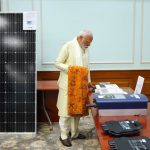Imagine a future in which energy never sets, where a thriving city in Europe is powered by sunlight captured in Africa’s deserts, and where energy knows no boundaries, freely flowing across continents like a river. Essentially, this is the idea behind “One Sun, One World, One Grid” (OSOWOG), an innovative project that seeks to establish an international network of renewable energy sources.
Destroyed by Ambition:
Launched in 2018 by Indian Prime Minister Narendra Modi, OSOWOG is a daring project. Its objective is to link national networks worldwide so that excess renewable energy produced in one place may be easily moved to regions that are in need of it. Energy access could be revolutionized, energy security issues might be resolved, and a sustainable future powered by wind and sunlight may be made possible by this interconnection.
Glistening Beyond Boundaries:
The advantages of OSOWOG are many.
- Leveling the energy playing field: Nations endowed with a wealth of solar or wind energy, such as those in Africa and Latin America, might export their excess energy to nations with lower natural resource bases, promoting energy justice and spurring economic development.
- Tackling climate change: OSOWOG would greatly lessen global reliance on fossil fuels by giving priority to renewable energy sources, which would lower greenhouse gas emissions and lessen the consequences of climate change.
- Improving energy security: Because interconnected grids provide redundancy and resilience, nations are less susceptible to localized interruptions and changes in the price of energy throughout the globe.
Brighter Days, Overcast Difficulties:
Although OSOWOG’s aim is motivating, there are several obstacles in the way of its realization:
- Infrastructure obstacles: Constructing a worldwide grid would need significant expenditures in advanced infrastructure improvements, cross-border transmission line construction, and grid harmonization amongst many governments.
- Geopolitical difficulties: It will be very difficult to navigate national interests, diverse energy policies, and political complexity across many different nations.
- Technological considerations: There are several technical obstacles to overcome, including integrating various grid systems, maintaining cyber security, and regulating energy flows across various time zones and weather patterns.
Nearby Horizon:
In spite of the obstacles, OSOWOG continues to be a ray of hope for the worldwide movement towards clean, affordable energy. The difficulties may be solved by coordinated efforts from governments, international organizations, and private parties. Large-scale deployment is made possible by the ongoing pilot programs, such as the UK, France, and India’s Green Grids Initiative, which are offering insightful information.
A Goal Deserving of Pursuit:
Although One Sun, One World, One Grid may seem like a futuristic paradise, there are certain advantages. This ambitious endeavor, powered by the sun’s limitless energy, has the potential to usher in a better future for everybody by uniting the globe behind the common flag of renewable energy. Whether it’s a far-off hint or a nearing dawn, OSOWOG serves as a reminder that a society driven by common goals and resources is not only feasible, but also essential.








